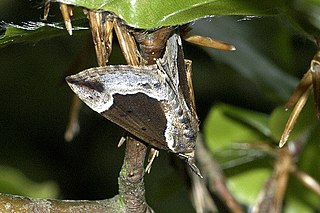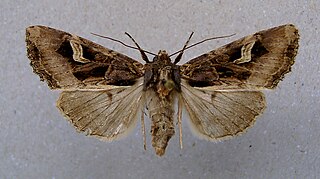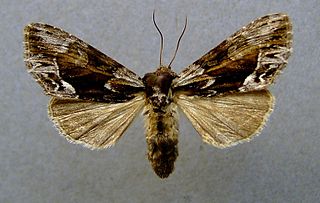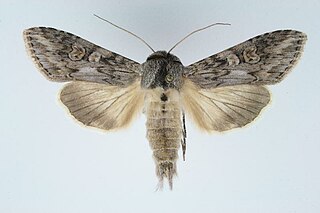
Apamea ophiogramma, the double lobed, is a moth of the family Noctuidae. It is found in the Palearctic realm in North and Central Europe to the Urals, Turkestan, Russian Far East, and Siberia. There have been at least two separate introductions into North America and it is now rapidly expanding in range. This species is sometimes placed in the monotypic genus Lateroligia.

Autographa pulchrina is a moth of the family Noctuoidea. It is found in Europe East to the Urals and the Caucasus.Also in the Khentii Mountains (Mongolia) and East Siberia.

Mormo maura, the old lady or black underwing, is a species of moth of the family Noctuidae. The species was first described by Carl Linnaeus in the 10th edition of his Systema Naturae. It is found in the Palearctic realm, from north-western Africa through all over southern Europe. It reaches its northern border in the west in northern Ireland and central Scotland, in central Europe, in northern Germany and Poland. In some Nordic countries, there are single finds. The other occurrence areas include Turkestan, Anatolia, the Middle East and Iraq. The name "old lady" refers to the fact that the wing pattern was said to resemble the shawls worn by elderly Victorian ladies.

Hypena crassalis, the beautiful snout, is a moth of the family Erebidae. The species was first described by Johan Christian Fabricius in 1787. It is found in Europe.

Hydraecia micacea, the rosy rustic, is a moth of the family Noctuoidea. It is found across the Palearctic realm from Ireland to Siberia. It reaches Japan and is introduced to eastern USA, Quebec and Ottawa.

Dysgonia algira, the passenger, is a moth of the family Noctuidae. The species was first described by Carl Linnaeus in 1767 and is found in the Palearctic - from the southern half of Europe and parts of North Africa through West, Central and South Asia.

Plusia festucae is a species of moth of the family Noctuidae. It is found throughout the Palearctic realm from Ireland to Japan.

Dypterygia scabriuscula, the bird’s wing, is a moth of the family Noctuidae. The species can be found in Europe and the western Palearctic.

The Early Grey(Xylocampa areola) is a species of moth of the family Noctuidae. It is found in Europe and Morocco.

Helotropha leucostigma, the crescent, formerly Celaena leucostigma is a moth of the family Noctuidae. It is found in the Palearctic realm.

The gold spangle is a moth of the family Noctuidae. The species was first described by Michael Denis and Ignaz Schiffermüller in 1775. It is found in Europe, across western Siberia and the Altai Mountains, the northern Caucasus, northern Turkey and northern Iran.

Autographa jota, commonly known as plain golden Y, is a moth of the family Noctuidae. The nominate form is found in Europe. while the subspecies Autographa jota anatolica is found in the southern Balkans, south-western Asia, Turkey, the Caucasus, and north-western Iran.

Catocala nymphagoga, the oak yellow underwing, is a moth of the family Erebidae. It is found in Southern Europe, from Bulgaria up to the Iberian Peninsula and sometimes further north as a migrant. It is also found in North Africa and Asia Minor.

The Essex y is a moth of the family Noctuidae. It is found from Italy to Greece, southeastern Europe, southwestern Russia, the southern parts of the Ural, Africa, Canary Islands, Arabia, southwestern Asia, Ceylon, from India to Nepal, southeastern China and Japan.

Schinia scutosa, the spotted clover, is a moth of the family Noctuidae. It is found from Europe to southern Siberia, the Near East and the Middle East and from central Asia to Japan. In North Africa it is found from Morocco to Egypt.

The flame brocade is a moth of the family Noctuidae. The nominate subspecies T. f. flammea is found in Europe, mostly in the Mediterranean area up to Normandy. It is also found on the Channel Islands and it has spread to Southern England and Ireland. It is found in the Maghreb as the subspecies T. f. vividior. This also occurs in parts of Spain. The species lives primarily in dry areas, on warm slopes, grassy scrubland and in karstic oak.

Hyppa rectilinea, the Saxon, is a moth of the family Noctuidae. It is found in Europe, but mostly in northern and central Europe. In the south, it is found in scattered populations, mainly in mountainous areas. To the east, its range stretches through northern Asia and eastern Siberia, up to the Pacific Ocean and Japan.

Cucullia artemisiae, or scarce wormwood, is a moth of the family Noctuidae. The species was first described by Johann Siegfried Hufnagel in 1766. It is found from central and southern Europe to Turkey and across the Palearctic to western Siberia, Central Asia, Manchuria, the Korean Peninsula and Japan.

Nycteola revayana, the oak nycteoline, is a moth of the family Nolidae. The species was first described by Giovanni Antonio Scopoli in 1772. It is found from Europe and east across the Palearctic to Japan and India.

Elaphria venustula is a moth of the family Noctuidae. It is found in most of Europe, except the north. In the east, the range extends through the Palearctic to the Pacific Ocean.





















